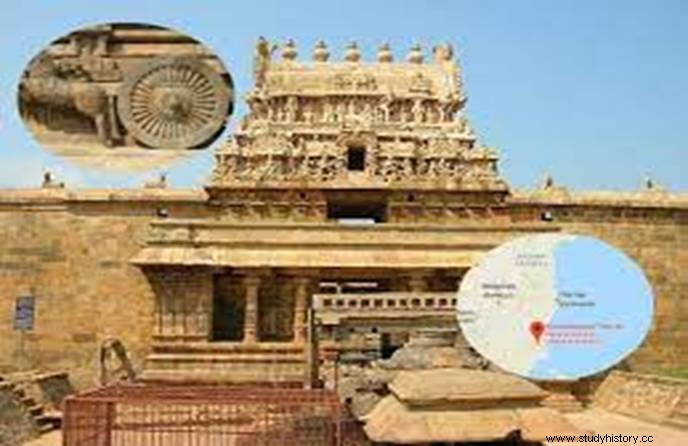
Sculpture of South India
In the temples of South India, so many sculptures have been engraved on the outer walls of the temple that the architectural features of the temple are hidden in the glare of the idols. We get information about Pallava sculpture through sculptures carved on the rocks of the mountains. In the Mamalla style pavilions, beautiful scenes of Gangavarana, Seshasayi Vishnu, Mahishasura slaughter, Varaha-avatar and Govardhan dharana have been engraved on the rocks of the mountains.
Efforts have been made to create dramatic effect in these scenes. 'Saptpagoda' of Mamalla style But big beautiful idols of gods and goddesses, animals and birds and men and women have been engraved. Like the chariot temples, these idols are also amazing. The idol of Bhagiratha, who descended the Ganges to earth, is 98 feet long and 43 feet wide by cutting a rock. These temples and idols appear to be immortal flags of the Pallava style.
The introduction of Rashtrakuta sculpture is found in the Kailashnath temple, Buddhist viharas and Jain temples of Ellora. The sculptures of Indra-Indrani engraved in the Kailashnath temple and the marking of Kailash-levitation by Ravana are very energetic and soulful. In this scene Ravana is lifting Kailash and the frightened Parvati is taking support of Shiva's huge arm, Parvati's friends are running away; Lord Shiva is standing motionless and is stabilizing Mount Kailash by pressing him with his feet.
The elephants carved on either side of the pylon are also invaluable treasures of sculpture. These idols have been praised by scholars. Among the existing statues in the Elephanta cave temples, the idols of Maheshwara's Trimurti, Shiva-Tandava and Shiva-Parvati marriage are very grand and artistic. Among them the three-faced Trimurti statue of Lord Shiva is the most famous. There is a feeling of divine peace on the three faces of the Lord.
Basham has written- 'This trinity will be said to be unique among Indian god-statues for its many characteristics. In the Shiva-Tandava idol, the devotion of Parvati has been displayed very beautifully.
A wonderful shade of sculpture is also seen in the Chola temples. Statues have been used to decorate walls, pillars, chairs of buildings, roofs and other places. Chola sculptors have engraved a large number of sculptures on the outer walls of the sanctum sanctorum, mandapas, pillars and gopuras, but there is an unusual balance in sculpture and architecture.
This characteristic of Chola temples is visible in all Chola temples, be it the Brihadisvara temple at Tanjore, the Rajarajeshwara temple at Gangaikonda-Cholapuram or the Erateshwara temple at Darasuram. Chola era sculpture is influenced by Shaivism.
In these many forms of Shiva, Parvati and Shiva have been expressed. Among these forms Vishnu Anugrah, Bhikshatana, Veerabhadra, Dakshina, Skeleton, embrace Chandrashekhar, Vrishavahana, Tripurantaka, Kalyan Sundar, Kalari, Arjuna-Anugrah, Ardhanarishvara, Lingodbhava, Bhairav, Madanantaka, Ravananugraha and Chandeshnugraha are particularly noteworthy. The Chola temples present a long series of Shiva forms. Despite the dominance of Shaivite idols, the deities of Vaishnavism have also been marked in abundance.
Statues of temple-builders rulers have also been made in Chola temples. Idols of Rajaraja the Great and his queen Lok Mahadevi have been installed in the Brihadisvara temple of Tanjore. The temple sculpture also features gatekeepers, sages, dancers and instrumental groups. The gatekeepers of the temples are wearing tridents and their eyes are outwards.
The dance tradition of that period also gets information from the idols of Chola temples. In these temples, 108 Bhangmis of Bharatanatyam have been depicted alive. On the walls of the Brihadisvara temple these dance gestures are depicted through Shiva himself, while in other places dancers are depicted performing this dance. His introduction is also written along with the idols on the Gopura of Chidambaram.
The early Chola sculptures are influenced by Pallava art. The Chola-statues made up to the tenth century have a long body and soft effect similar to the Pallava-statues. The lines of the body are natural and dynamic and the clothes appear to be an essential part of the body, but in the sculptures of the later period, the Chola art becomes free from the influence of the Pallava art.
Now the bodies of the idols become heavy and muscular and their length decreases. The clothes seem to be clinging to the body, stress-free and weightless. Jewelery has also helped in the beauty of the body and is not heavy but light. The crowns of these idols appear to be highly ornate and heavy. The male figure with the rounded face, heavy shoulders, protruding lips and ornate waistbands of the idols make a distinctive impression.
The trivali engraved on the navel region of the female idol in elongated physique explains the elegance and speed of the body. These statues are made of granite stone. Nataraja predominates in the Chola sculptures. The Nataraja of Nageshwar is the biggest and most beautiful of all the Natarajas. The Chola artists achieved special skill in the expression of Nataraja.
Although the Chola sculptures continued to be made till the twelfth century AD, the later sculptures do not show the same beauty as before. It is clear from these that the political conditions of the country were losing its balance, which was also affecting every sphere of life and arts.
